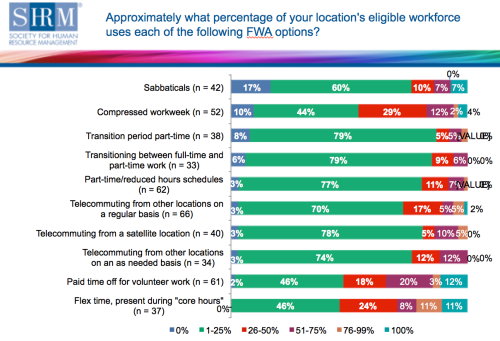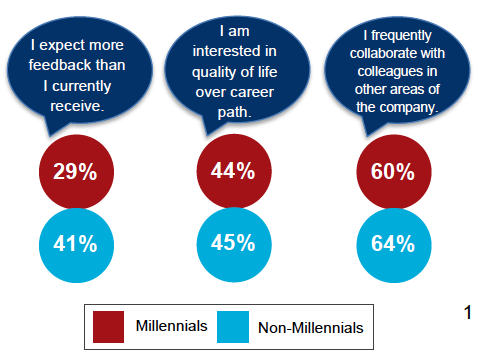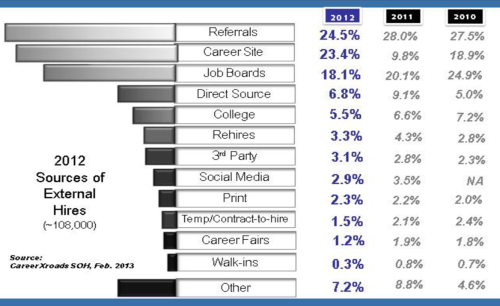 How would you describe flexible scheduling? Does a standard definition come to mind? In a new SHRM survey on FWAs (flexible work arrangements), which surveyed 525 HR professionals from a randomly selected sample of SHRM’s membership, “FWAs,” “flextime,” “workplace flexibility,” “flexible scheduling,” etc. are defined under the following definition: “… a dynamic partnership between employers and employees that defines how, when and where work gets done in ways that work for everyone involved (including families, clients and other stakeholders).” This seems a definition with an interesting amount of ambiguity to describe a practice that ultimately, is extremely different from company to company.
How would you describe flexible scheduling? Does a standard definition come to mind? In a new SHRM survey on FWAs (flexible work arrangements), which surveyed 525 HR professionals from a randomly selected sample of SHRM’s membership, “FWAs,” “flextime,” “workplace flexibility,” “flexible scheduling,” etc. are defined under the following definition: “… a dynamic partnership between employers and employees that defines how, when and where work gets done in ways that work for everyone involved (including families, clients and other stakeholders).” This seems a definition with an interesting amount of ambiguity to describe a practice that ultimately, is extremely different from company to company.
For organizations that responded as offering FWAs, 54% offered sabbaticals, 51% offered paid time-off for volunteer work, and 46% offered part-time/reduced hour schedules on a formal basis. Other FWAs were more likely to be offered informally.
Additionally, among organizations that reported offering FWA’s, more than 50% responded that the following FWAs were available to “all or most employees”: paid time-off for volunteer work (82%), unpaid time off for volunteer work (72%), break arrangements (61%) a part-time transition after a major life event (58%) and flex time with “core hours” (54%). Fourth-fifths of responding organizations reported that 13 out of 17 FWAs were somewhat or very successful (80%-90%). The four FWAs that responding organizations reported finding less successful were unpaid time off for volunteer work (78%), phased retirement (74%), shift arrangements (73%), and sabbaticals (66%). Despite the availability of FWAs at responding organizations (both successful and less successful FWAs), the majority of organizations were likely to report that only 1%-25% of their eligible workforce used each of the FWAs offered.
If an organization does offer flexible work arrangements, how are their employees finding out about these programs? According to SHRM’s survey, responding organizations that offered at least one type of FWA indicated employees most often learned about their organization’s FWA options from:
- HR staff (15%)
- Employee handbook or policy and procedures manuals (18%),
- During orientation/onboarding (19%)
- Line manager/supervisors (27%)
- During the recruitment or interview process (30%)
- While on the job (50%)
SHRM’s data highlights not only the rise of FWAs within organizations but that they are an increasingly desired organizational practice amongst employees. 32% of responding organizations indicated that requests for FWAs at their organization had increased in the past 12 months, while only 3% indicated those requests had decreased.
SHRM’s data also indicates that telecommuting as an FWA option offers potential increases in employee productivity. Of the 39% of responding organizations that indicated they offered employees the option to telecommute, one-quarter indicated the productivity of employees who were previously 100% onsite increased, and one-third indicated absenteeism rates had decreased. When SHRM asked organizations about changes in FWAs and telecommuting over the next five years, the overwhelming majority of organizations stated it was somewhat or very likely that FWAs (89%) and telecommuting (83%) would be more commonplace in five years. Nearly half (48%) of these organizations stated it was somewhat or very likely that FWAs would be available to a larger proportion of their organization’s workforce in five years, while 39% indicated it was somewhat or very likely that a larger proportion of their organization’s workforce would be telecommuting.
SHRM’s FWA survey points to a number of important take-aways for organizations’ flexible scheduling policies, such as the reported positive impact of FWAs on productivity, job satisfaction, retention and employee health. This indicates that more organizations could benefit from offering FWAs, and those that already offer these options may find themselves with a competitive advantage. Despite the positive outcomes of flexible work arrangements, SHRM’s survey also highlights the low level of utilization by many employees. Organizations should make sure the decision to not partake in FWAs does not stem from job security fears, or culture perceptions that may make using FWAs seem like career limiting moves. Managers must remember that as employees are most likely to learn about FWAs on the job, their role is vital to the success of FWA programs. HR needs to ensure that managers are aware of all available FWA options, have proper training on how to inform employees about FWAs, and that they “practice what they preach” by utilizing such programs themselves.

























